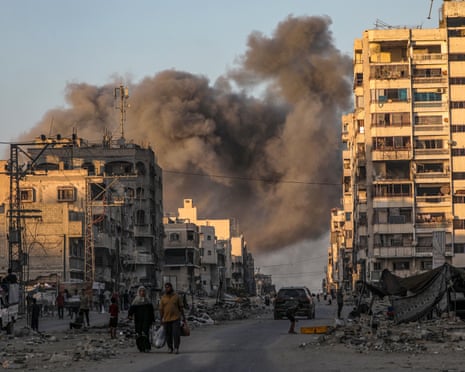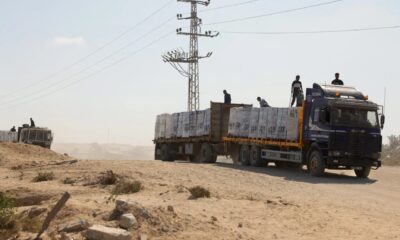World
IDF Limits Humanitarian Protection in Northern Gaza Amid Conflict

Humanitarian workers in northern Gaza face a dire situation as the Israeli military has clarified that only hospitals will be designated as protected sites. All other aid infrastructure is at risk of being targeted. Recent communications from the Israel Defense Forces (IDF) indicate that an evacuation order for Gaza City, home to approximately 1 million residents, applies to all humanitarian locations except hospitals. The IDF has stated that operations aimed at defeating Hamas will be conducted with “great force.”
The escalation in military activity has prompted a mass exodus, with estimates suggesting that between 250,000 and 500,000 residents have already fled. Many displaced individuals, however, report feeling trapped, lacking the resources to escape. The cost of transportation for the arduous journey south has surged, with some vehicles now charging as much as $2,000 (£1,500).
Toufic Abu Mouawad, a displaced resident, described the intense conditions, stating, “The situation is really bad. All night long, the tank was firing shells. I want to flee with the boys, the girls, the children. This is the situation that we are living in. It is a very tragic situation.”
In response to the growing humanitarian crisis, Israeli officials have announced plans to establish a “humanitarian zone” in the overcrowded al-Mawasi coastal area in southern Gaza. This initiative includes building new aid distribution sites, enhancing electricity supply to desalination plants, and increasing the influx of humanitarian aid.
As conflict continues, much of northern Gaza lies in ruins, with civilian infrastructure severely damaged. If Israeli forces take full control of Gaza City, the remaining population of the territory, estimated at 2.1 million, will be confined to a small enclave in the south. The main entry points for goods and people into Gaza are currently limited to the southern border, following the closure of the Zikim checkpoint last week.
The humanitarian situation has deteriorated significantly over the past 23 months of conflict. A senior aid official working in Gaza remarked, “People might want to go back but what would they go back to? It is very difficult to imagine how it could work.” This sentiment reflects the deep emotional ties many have to their homes, juxtaposed against the grim realities of destruction and displacement.
The Israeli military has announced the establishment of two new aid distribution hubs near Gaza’s southern border with Egypt, set to be operated by the Gaza Humanitarian Foundation (GHF). This organization, which began operations in May, has faced scrutiny due to its opaque funding and management. Currently, GHF runs five aid sites, although three have reportedly been shut down. It confirmed that on a recent Wednesday, 12 truckloads of food were distributed at two operational sites in southern Gaza—one in Rafah and another in Khan Younis.
Despite these efforts, logistics remain a significant challenge. Aid convoys from the south encounter severe restrictions and often face refusals from the IDF. Following a famine declaration in Gaza City by UN-backed experts last month, the urgency for aid delivery has heightened. The IDF has expanded the Kissufim crossing to facilitate more aid reaching the designated humanitarian zone, but this expansion only serves the south.
As of now, approximately 250 trucks are reportedly delivering essential supplies to Gaza daily. While this marks an improvement from previous months, experts warn that it remains insufficient to address the ongoing humanitarian crisis. Katy Crosby, Senior Director of Policy and Advocacy at Mercy Corps, stated, “It is better no doubt than in June and July but not the kind of better that will move the needle in any major way on the famine, for children dying of malnutrition or in terms of the day-to-day life of the average Gazan.”
The aid situation is further complicated by the nature of supplies entering Gaza. A significant proportion of the incoming trucks carry non-essential items such as soft drinks and snacks, which are costly and non-nutritive. Observers suggest that the latest military offensive may have political motives, with some attributing it to efforts by Prime Minister Benjamin Netanyahu to maintain a state of war and prevent early elections that could threaten his coalition.
Recent comments from Bezalel Smotrich, Israel’s far-right finance minister, who referred to Gaza as a “real-estate bonanza,” have also drawn criticism and raised concerns about the underlying intentions behind the current military actions.
As the conflict continues to unfold, the humanitarian crisis in Gaza deepens, with aid workers and officials grappling with an increasingly complex and dangerous landscape.
-

 Entertainment3 months ago
Entertainment3 months agoAnn Ming Reflects on ITV’s ‘I Fought the Law’ Drama
-

 Entertainment4 months ago
Entertainment4 months agoKate Garraway Sells £2 Million Home Amid Financial Struggles
-

 Health3 months ago
Health3 months agoKatie Price Faces New Health Concerns After Cancer Symptoms Resurface
-

 Entertainment3 months ago
Entertainment3 months agoCoronation Street’s Carl Webster Faces Trouble with New Affairs
-

 Entertainment3 months ago
Entertainment3 months agoWhere is Tinder Swindler Simon Leviev? Latest Updates Revealed
-

 Entertainment4 months ago
Entertainment4 months agoMarkiplier Addresses AI Controversy During Livestream Response
-

 Science1 month ago
Science1 month agoBrian Cox Addresses Claims of Alien Probe in 3I/ATLAS Discovery
-

 Entertainment4 months ago
Entertainment4 months agoKim Cattrall Posts Cryptic Message After HBO’s Sequel Cancellation
-

 Entertainment3 months ago
Entertainment3 months agoOlivia Attwood Opens Up About Fallout with Former Best Friend
-

 Entertainment6 days ago
Entertainment6 days agoCoronation Street Fans React as Todd Faces Heartbreaking Choice
-

 Entertainment3 months ago
Entertainment3 months agoMasterChef Faces Turmoil as Tom Kerridge Withdraws from Hosting Role
-

 Entertainment4 months ago
Entertainment4 months agoSpeculation Surrounds Home and Away as Cast Departures Mount





















